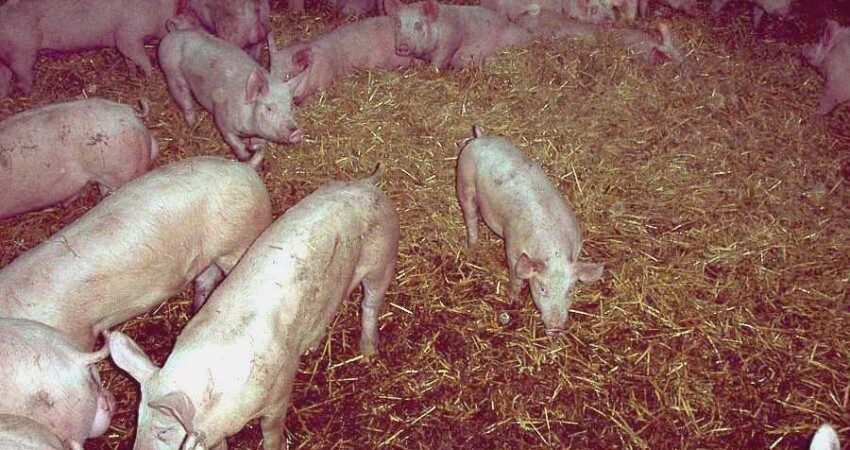

Swine Dysentery has long been recognised as a major disease of pigs throughout the world and can be seen in all types of pig keeping operations. The causative bacterium is identified as Brachyspira hyodysenteriae, but previously known as Treponema and Serpulina hyodysenteriae. Dysentery, as a pathological condition, is typified by bloody diarrhoea and in its original form this is how the disease presented in pigs. However, Brachyspira hyodysenteriae is not the only cause of bloody diarrhoea in the pig, but conversely it is now recognised that not all strains of Brachyspira hyodysenteriae cause classic signs of Swine Dysentery.
Clinical Presentation
The typical pig affected with swine dysentery will appear dull, depressed and inappetant with sunken (or slab) sides to its abdomen. Dehydration is common. The faeces will range from soft to almost water, containing blood, mucous and in severe cases necrotic gut lining. It will give off a distinctive and unpleasant smell. The disease runs over a number of days, with initially raised rectal temperatures up to 41°C (106°F) but this will fall over a few days. Death can result early on or later and may itself be the result of dehydration/salt poisoning.
As a group disease, signs will spread steadily within and between pens over a number of days – rather than explosively. Untreated and uncontrolled, the disease will persist within dynamic production systems for prolonged periods of time, if not permanently, whereas in fixed populations survivors that fully recover will throw off infection over time and the disease can eventually burn itself out.
In a naïve population, the disease can occur in all age groups of pigs – as young as 2-3 weeks of age and in adults. However, it is most typically a disease of the growing pig above 12 weeks of age and in chronically infected herds disease is often restricted to this age group.
Diet can have dramatic effects on the severity of the disease and some studies have shown that even in the face of severe challenge, pigs fed on cooked white rice show little sign. Swine Dysentery is a disease of the large intestine (colon) and this suggests that digestibility of the diet can affect the growth of the organism in the gut and the damage it subsequently does – the better the diet is digested in the small intestine, the less substrate will pass down the gut on which the organism will thrive. Diets with high levels of non-starch polysaccharides tend to induce more scour (with or without SD) as do pelleted diets compared to meal feeding.
Individual pigs that survive infection can range from fully recovered to chronically stunted with permanent diarrhoea. In recent years, ‘milder’ strains of Brachyspira hyodysenteriae have been recognised which present more as a low grade, cow-pat like, grower scour than as frank dysentery. However, these strains appear to have the ability to ‘drift’ within a population, causing variable levels of disease.
Diagnosis
Swine dysentery should be suspected in any situation where spreading scour is seen particularly in growing pigs, and certainly where there is any sign of blood or mucous in the scour.
Post mortem examination of affected pigs- either freshly dead by natural causes of the disease or by euthanasia – will show signs typical of swine dysentery within the spiral colon – oedema within the gut wall with congestion with swollen lymph nodes.
The inside lining of the large intestine (colon) will be inflamed, necrotic, blood streaked and with foul smelling material adhered to the surface. In milder cases the colon may only appear mildly congested and inflamed with watery grey contents. Of course, in the smaller populations where mortality does not occur, there is understandably a reluctance to sacrifice pigs for diagnostic purposes and if animals do not justify euthanasia on welfare grounds the diagnosis will be based on clinical signs supported by examination of faecal samples
The organism can be demonstrated in faeces, gut contents and mucosal scrapings by PCR tests, which have largely superseded a range of other laboratory tests. It is possible to see spiral organisms under the microscope in wet smears prepared from typically affected gut lining.
Other diseases that can mimic swine dysentery in the growing pig include Salmonella, Swine Fever, severe Spirochaetal diarrhoea (Brachyspira pilosicoli infection) and Trichuris suis infection (particularly a risk in outside conditions of prolonged occupation and contamination) whereas the less specific growers scours can arise as a result of dietary indigestion, chilling and infection with a wide range of organisms that include B. pilosicoli, Yersinia, E.coli, Salmonella and Lawsonia. Secondary invasion of the colon by Balantidium coli – a commensal gut parasite – can produce signs of blood and mucous making diagnosis complex.
Treatment
Tiamulin and Lincomycin can be effective treatments given by injection or in water, and both of these products along with Valnemulin and Tylvalocin are available as in-feed products, which can be used at different levels, under veterinary direction, to effect treatment. As with any systemic disease, treatment of the sick pig by injection is essential and in the smaller populations may be the technique of choice for all pigs. However, there is an increasing concern that resistance to all of these antibiotics is increasing, potentially making treatment and control extremely challenging. Lincomycin had previously declined in efficacy following extensive use and the development of resistant strains but there has been some evidence that Brachyspira susceptibility has returned and may be effective where resistance to the pluromutilins (tiamulin & valnemulin) has occurred.
 Contact Jaguza Support
Contact Jaguza Support